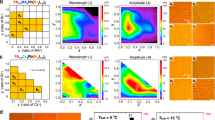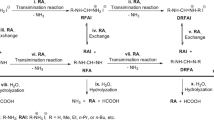Abstract
RECENTLY many workers1 have reported on the formation of periodic precipitates in the absence of another gel. We have obtained periodic precipitates in the slow coagulation of sols of ferric hydroxide, chromic hydroxide, and stannic hydroxide by small quantities of univalent electrolytes like potassium chloride and sodium bromate. Freshly precipitated ferric hydroxide was peptised by the minimum quantity of acetic acid, which was then boiled off ; the sol was further purified by hot dialysis. The concentration of the purified sol was 39.2 gm. per litre. The chromic hydroxide sol was obtained by adding ammonium carbonate solution to hot chromic chloride and then purified by continuous hot dialysis. The concentration of the purified sol was 32.5 gm. per litre.
This is a preview of subscription content, access via your institution
Access options
Subscribe to this journal
Receive 51 print issues and online access
$199.00 per year
only $3.90 per issue
Buy this article
- Purchase on SpringerLink
- Instant access to full article PDF
Prices may be subject to local taxes which are calculated during checkout
Similar content being viewed by others
References
NATURE, 128, 1042, Dec. 19, 1931; 129, 205, Feb. 6, 1932.
N. R. Dhar and A. C. Chatterji, J. Phys. Chem., 28, 41; 1924. Kolloid. Zeit., 37, 3, 89; 1925. Z. anorg. Chem., 159, 129, 186; 1926.
Author information
Authors and Affiliations
Rights and permissions
About this article
Cite this article
DHAR, N., MITTRA, R. Formation of Periodic Precipitates in the Absence of a Foreign Gel. Nature 129, 761 (1932). https://doi.org/10.1038/129761b0
Issue date:
DOI: https://doi.org/10.1038/129761b0
This article is cited by
-
Liesegang rings ? a phenomenon of precise periodic coagulation
Kolloid-Zeitschrift (1958)



